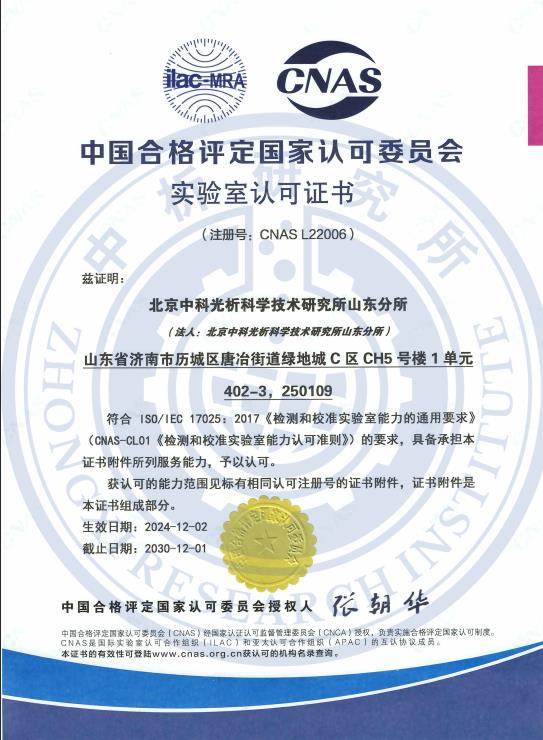ISO分辨率检测
1对1客服专属服务,免费制定检测方案,15分钟极速响应
发布时间:2025-07-24 06:58:03 更新时间:2025-07-23 06:58:03
点击:0
作者:中科光析科学技术研究所检测中心
1对1客服专属服务,免费制定检测方案,15分钟极速响应
发布时间:2025-07-24 06:58:03 更新时间:2025-07-23 06:58:03
点击:0
作者:中科光析科学技术研究所检测中心
ISO resolution detection is a critical standardized process developed by the International Organization for Standardization (ISO) to evaluate the resolving power of imaging devices, such as digital cameras, displays, medical scanners, and security systems. Resolution, defined as the ability to distinguish fine details in an image, is a fundamental metric for image quality, impacting applications across photography, manufacturing, healthcare, and consumer electronics. ISO standards provide a consistent, objective framework for this detection, ensuring global comparability and reliability. Without standardized resolution testing, devices may suffer from inconsistencies in sharpness, contrast, and detail reproduction, leading to poor user experiences or critical errors in diagnostic imaging. This process involves rigorous protocols to measure spatial frequencies and contrast levels, helping manufacturers optimize device performance and meet regulatory requirements. In today's tech-driven world, ISO resolution detection plays a vital role in driving innovation and quality assurance, with standards evolving to address advancements in high-resolution displays and AI-driven imaging.
In ISO resolution detection, specific items are evaluated to assess image clarity and detail retention. Key detection items include spatial resolution, measured in line pairs per millimeter (lp/mm) or cycles per pixel, which quantifies the smallest resolvable detail. Another essential item is the Modulation Transfer Function (MTF), which analyzes contrast at various spatial frequencies to determine how well a device preserves image sharpness. Additional items encompass edge sharpness evaluation, signal-to-noise ratio (SNR) assessment for noise interference, and aliasing detection in digital sensors. These items collectively provide a comprehensive profile of a device's imaging capabilities, helping identify limitations in fine detail reproduction.
Specialized instruments are employed for accurate ISO resolution detection. Primary tools include resolution test charts, such as the ISO 12233 test chart for digital cameras, which features slanted-edge patterns, Siemens stars, and sinusoidal grids. High-resolution cameras or microscopes capture images under controlled lighting, while image analysis software (e.g., Imatest or MATLAB-based tools) processes data to calculate metrics like MTF or lp/mm. Other instruments involve light sources with adjustable intensity for uniform illumination, calibration targets for reference measurements, and photometers to ensure environmental consistency. These instruments are calibrated to ISO standards to minimize errors and ensure repeatable results across tests.
ISO resolution detection follows structured methods to guarantee precision. The process typically begins with setting up the device under test in a controlled environment, using an ISO-compliant test chart. Standard methods include the slanted-edge technique, where an image of a high-contrast edge is captured and analyzed using Fourier transforms to compute MTF values. For spatial resolution, methods involve counting resolvable line pairs in test patterns or employing frequency sweep tests. Additional approaches include multiple-image averaging to reduce noise and comparative analysis against reference devices. These methods, detailed in ISO guidelines, emphasize reproducibility by specifying parameters like viewing distance, lighting conditions, and exposure settings.
Key ISO standards govern resolution detection to ensure uniformity and reliability. The primary standard is ISO 12233:2017, "Photography — Electronic still picture imaging — Resolution and spatial frequency responses," which outlines procedures for digital cameras, including chart specifications and MTF calculations. Other relevant standards include ISO 9039 for optical system resolution, ISO 15739 for noise and dynamic range assessments, and ISO 14524 for exposure-related tests. These standards provide detailed criteria for acceptable resolution levels, test environments, and reporting formats. Compliance with these benchmarks enables cross-industry validation, such as in automotive displays or medical imaging, fostering trust in product performance.

证书编号:241520345370

证书编号:CNAS L22006

证书编号:ISO9001-2024001















版权所有:北京中科光析科学技术研究所京ICP备15067471号-33免责声明